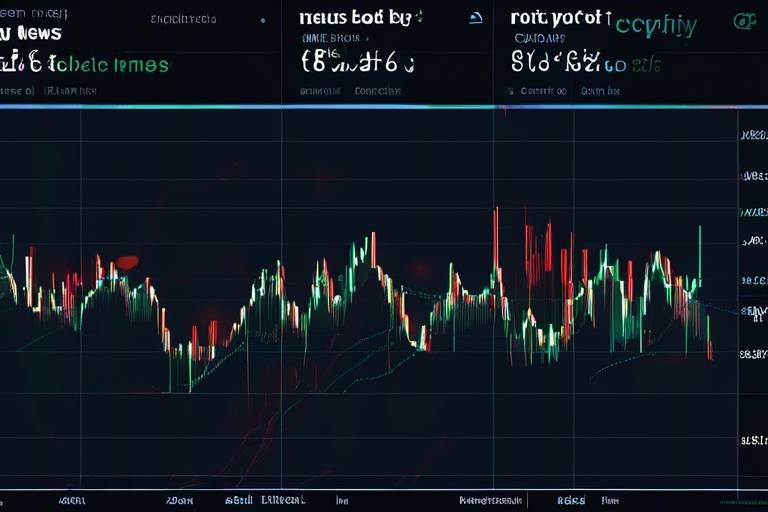Impact of Global Economic Events on Cryptocurrency Prices
The world of cryptocurrency is a thrilling roller coaster ride, where prices can soar to dizzying heights or plummet to unforeseen lows in the blink of an eye. This volatility is not just a quirk of the market; it is intricately linked to global economic events that shape the financial landscape. As the world grapples with inflation, unemployment rates, and geopolitical tensions, these factors ripple through the cryptocurrency markets, influencing investor sentiment and market dynamics. In this article, we will explore how various global economic events impact cryptocurrency prices, analyzing key components such as market sentiment, regulatory changes, and macroeconomic indicators.
To understand the impact of global economic events on cryptocurrencies, we must first acknowledge that cryptocurrencies are not immune to the broader financial environment. Just like traditional assets, cryptocurrencies respond to changes in economic indicators. For instance, when inflation rises, many investors turn to cryptocurrencies as a hedge against the eroding purchasing power of fiat currencies. This behavior is driven by a desire to protect wealth and seek alternative investment avenues during uncertain times.
Moreover, regulatory changes can create waves of uncertainty in the cryptocurrency market. The announcement of new regulations can lead to immediate price fluctuations, as investors react to the potential implications for market stability and trust. In recent years, we've witnessed how countries' stances on cryptocurrencies can either bolster or undermine investor confidence, resulting in significant price shifts. The interplay between regulatory announcements and market reactions exemplifies the intricate dance between global economic events and cryptocurrency prices.
In addition to inflation and regulations, macroeconomic events, such as financial crises and geopolitical tensions, can also have profound effects on the cryptocurrency landscape. For example, during times of economic downturn, cryptocurrencies often experience a surge in interest as investors seek refuge from traditional markets. This phenomenon highlights how cryptocurrencies can serve as alternative investments, especially when traditional financial systems come under pressure.
As we delve deeper into the relationship between global economic events and cryptocurrency prices, we will examine specific case studies and historical patterns that reveal the complex dynamics at play. By understanding these influences, investors can better navigate the unpredictable waters of the cryptocurrency market and make more informed decisions in an ever-evolving financial landscape.
- How do global economic events affect cryptocurrency prices?
Global economic events influence investor sentiment, regulatory environments, and macroeconomic conditions, all of which can lead to significant price fluctuations in cryptocurrencies.
- What role does inflation play in cryptocurrency investment?
Inflation can lead investors to seek cryptocurrencies as a hedge against the declining purchasing power of traditional currencies, often driving up demand and prices.
- How do regulatory changes impact the cryptocurrency market?
Regulatory developments can create uncertainty and volatility, with new regulations potentially leading to immediate price changes as investors react to the implications.
- Can cryptocurrencies serve as a safe haven during financial crises?
Yes, during financial crises, cryptocurrencies often see increased interest as investors look for alternative assets that may offer more stability compared to traditional markets.

Understanding Cryptocurrency Volatility
Cryptocurrencies are often described as the wild west of the financial world, characterized by their notorious price volatility. But why does this volatility exist? To understand the rollercoaster ride of cryptocurrency prices, we need to dive into several underlying factors that contribute to these dramatic fluctuations. First and foremost, market speculation plays a significant role. Investors often buy and sell based on their predictions of future price movements rather than intrinsic value, which creates a cycle of hype and panic. This speculative behavior can lead to sharp price increases followed by equally steep declines.
Another crucial factor is liquidity. Unlike traditional markets, where large volumes can be traded without significantly affecting prices, the cryptocurrency market is still relatively small. This means that even a single large transaction can lead to significant price swings. For instance, if a major investor decides to sell a large amount of Bitcoin, it can trigger a domino effect, causing panic among other investors and leading to a rapid decline in prices.
Investor behavior is also a key player in this volatility. Many cryptocurrency investors are retail traders who are influenced by emotions rather than sound investment strategies. The fear of missing out (FOMO) can lead to impulsive buying during price surges, while fear, uncertainty, and doubt (FUD) can trigger mass sell-offs during downturns. This emotional trading creates a volatile environment where prices can swing wildly in a matter of hours or even minutes.
To illustrate the impact of these factors, consider the following table that summarizes the key contributors to cryptocurrency volatility:
| Factor | Description | Impact on Volatility |
|---|---|---|
| Market Speculation | Investors trading based on predictions rather than value. | High |
| Liquidity | The ease of buying/selling without affecting prices. | Moderate to High |
| Investor Behavior | Emotional trading driven by FOMO and FUD. | Very High |
In conclusion, understanding cryptocurrency volatility requires a grasp of these interconnected factors. The interplay between speculation, liquidity, and investor psychology creates an environment where prices can change rapidly, often without warning. As the market matures, we may see these fluctuations stabilize over time, but for now, the volatility remains a defining characteristic of the cryptocurrency landscape.
- What causes cryptocurrency prices to fluctuate? Prices fluctuate due to market speculation, liquidity issues, and investor behavior.
- Is cryptocurrency volatility a good or bad thing? It can be both; while it offers opportunities for high returns, it also poses significant risks.
- How can investors manage volatility? Investors can use strategies such as diversification and dollar-cost averaging to mitigate risks.

Global Economic Indicators
When we talk about the world of cryptocurrencies, it’s essential to understand the that can sway market trends and influence prices. These indicators serve as vital signposts, guiding investors and traders through the often turbulent waters of the crypto market. Think of them as the weather forecast for your financial decisions—just like you wouldn't head out in a storm without checking the forecast, you shouldn't dive into crypto without considering these economic signals.
Some of the most significant economic indicators include inflation rates, unemployment rates, and GDP growth. These metrics can provide insight into the overall health of the economy, and consequently, they can have a profound impact on cryptocurrency prices. For instance, when inflation rises, the purchasing power of fiat currencies tends to decline, prompting investors to seek refuge in digital assets like Bitcoin and Ethereum. This shift in investor behavior can lead to increased demand for cryptocurrencies, driving their prices up.
Moreover, the unemployment rate is another critical factor. High unemployment often signals economic instability, which can lead to a lack of confidence in traditional financial systems. In such scenarios, people may turn to cryptocurrencies as a more stable and reliable store of value. On the flip side, when unemployment is low and the economy is booming, traditional investments may seem more appealing, potentially diverting attention away from crypto.
| Economic Indicator | Impact on Cryptocurrency |
|---|---|
| Inflation Rate | Increased interest in cryptocurrencies as a hedge against declining purchasing power. |
| Unemployment Rate | High rates may lead to increased investment in cryptocurrencies as a safe haven. |
| GDP Growth | Strong growth can boost investor confidence in traditional markets, potentially reducing crypto investments. |
Additionally, GDP growth serves as another crucial indicator. A growing economy typically means higher consumer confidence and spending, which can lead to increased investments in various assets, including cryptocurrencies. However, if the growth is perceived as unsustainable or is accompanied by rising inflation, it could have the opposite effect, prompting investors to seek safer havens like digital currencies.
In summary, understanding these global economic indicators is key for anyone looking to navigate the cryptocurrency landscape effectively. They help paint a broader picture of market sentiment and can serve as a barometer for potential price movements. By keeping an eye on these factors, investors can make more informed decisions and potentially capitalize on the ever-shifting tides of the crypto market.
- What are global economic indicators?
Global economic indicators are statistics that provide insight into the health and direction of an economy, such as inflation, unemployment, and GDP growth. - How do these indicators affect cryptocurrency prices?
Changes in these indicators can influence investor behavior, leading to increased or decreased demand for cryptocurrencies. - Why is inflation particularly important for cryptocurrencies?
Rising inflation can erode purchasing power, prompting investors to look for alternative assets like cryptocurrencies to protect their wealth.

The Role of Inflation
Inflation plays a pivotal role in shaping the financial landscape, influencing everything from consumer purchasing power to investment strategies. As prices rise, the value of money diminishes, prompting individuals and institutions to seek alternatives that can preserve their wealth. This is where cryptocurrencies come into play. Investors often turn to digital currencies like Bitcoin and Ethereum as a hedge against inflation, viewing them as a safeguard for their assets in uncertain economic times.
When inflation rates soar, traditional assets like cash and bonds may lose their appeal due to diminishing returns. The allure of cryptocurrencies as a decentralized, limited-supply asset becomes increasingly attractive. For instance, Bitcoin's capped supply of 21 million coins creates a scarcity that can counterbalance inflationary pressures. This concept resonates with many investors who are wary of the eroding value of fiat currencies, making them more likely to allocate a portion of their portfolios to cryptocurrencies.
To illustrate the relationship between inflation and cryptocurrency adoption, consider the following key factors:
- Increased Demand: As inflation rises, individuals often seek alternative investments, leading to increased demand for cryptocurrencies.
- Market Perception: The perception of cryptocurrencies as "digital gold" strengthens during inflationary periods, further driving interest and investment.
- Institutional Adoption: Institutions may diversify their holdings by investing in cryptocurrencies, viewing them as a strategic move against inflation.
Historical data supports this trend, showcasing how cryptocurrencies tend to perform well during inflationary environments. For example, during the inflation spikes of the 1970s, gold prices surged, and similarly, recent years have seen Bitcoin's value rise in response to increasing inflation rates. This correlation suggests that as inflation expectations grow, so does the interest in cryptocurrencies as a viable alternative investment.
Moreover, inflation hedging strategies are becoming more sophisticated. Investors are not only buying cryptocurrencies outright but are also exploring various financial instruments that allow them to capitalize on the price movements of these digital assets. For example, some investors engage in futures trading or invest in cryptocurrency-related funds, which can provide exposure to the market without the need to hold the assets directly.
In conclusion, the role of inflation in the cryptocurrency market is significant and multifaceted. As inflation continues to impact the global economy, the demand for cryptocurrencies as a hedge is likely to grow. Understanding this dynamic can empower investors to make informed decisions in navigating the ever-evolving landscape of digital assets.

Historical Context of Inflation
When we dive into the , it's like opening a treasure chest filled with insights that can help us understand the present and predict the future. Inflation has been a constant companion in the economic journey of nations, often leading to significant shifts in investment strategies, particularly in the realm of cryptocurrencies. Historically, periods of high inflation have prompted investors to seek alternative assets to preserve their purchasing power. This is where cryptocurrencies come into play, as they are increasingly viewed as a hedge against the eroding value of fiat currencies.
For instance, during the 1970s oil crisis, many investors turned to gold and other tangible assets as inflation soared. Fast forward to today, and we see a similar trend emerging with cryptocurrencies. As inflation rates climb, many individuals are beginning to perceive digital currencies like Bitcoin and Ethereum as modern-day equivalents of gold. The allure of decentralized finance and the promise of limited supply in many cryptocurrencies resonate deeply with those looking to safeguard their wealth.
To illustrate this point, we can look at the following table that highlights key inflationary periods and the corresponding performance of major cryptocurrencies:
| Year | Inflation Rate (%) | Bitcoin Price (USD) | Ethereum Price (USD) |
|---|---|---|---|
| 2008 | 3.84 | 0.08 | N/A |
| 2011 | 3.16 | 6.00 | 0.95 |
| 2020 | 1.23 | 29,000 | 730 |
| 2022 | 7.48 | 19,000 | 1,300 |
This table clearly shows that as inflation rates have fluctuated, so too have the prices of cryptocurrencies. The correlation between rising inflation and increased interest in cryptocurrencies is evident. Investors are not just reacting to numbers; they are making calculated decisions based on historical precedents and the potential for future gains.
Moreover, the psychological aspect of investing during inflationary times cannot be overlooked. When inflation rises, it creates a sense of urgency among investors. They feel the pressure to act quickly, often leading to increased buying activity in the cryptocurrency markets. This behavior is fueled by media narratives and social media discussions that amplify the urgency to invest in what many see as the future of money.
In summary, understanding the provides valuable insights into why cryptocurrencies are gaining traction as a viable investment option. As we continue to witness economic fluctuations, it’s essential for investors to remain vigilant and informed about how these historical trends can influence their decisions in the ever-evolving landscape of digital currencies.
- What is the relationship between inflation and cryptocurrency prices?
Inflation can lead to increased interest in cryptocurrencies as investors seek alternatives to preserve their purchasing power. - How do historical inflation rates affect current cryptocurrency investments?
Historical trends show that during high inflation periods, cryptocurrencies often see a surge in demand as safe-haven assets. - Are cryptocurrencies a reliable hedge against inflation?
While many investors view cryptocurrencies as a hedge against inflation, their volatility means they can also carry significant risks.

Inflation Hedging Strategies
When it comes to hedging against inflation, cryptocurrencies have emerged as a popular choice among investors seeking to protect their wealth. But what exactly does it mean to hedge against inflation? Simply put, it involves taking steps to mitigate the impact of rising prices on your investment portfolio. In the world of finance, inflation can erode purchasing power, making it essential for investors to look for assets that can retain or even increase their value over time.
One of the most common strategies for hedging against inflation is to invest in hard assets, such as real estate or commodities. However, with the rise of digital currencies, many are turning to cryptocurrencies as a modern alternative. Cryptocurrencies like Bitcoin are often viewed as "digital gold," offering a finite supply that can help shield investors from inflationary pressures. The limited supply of Bitcoin, capped at 21 million coins, creates a scarcity that can drive up its value as demand increases, especially during periods of high inflation.
Another strategy is to diversify your portfolio. By spreading your investments across various asset classes, including cryptocurrencies, stocks, and bonds, you can reduce the overall risk associated with inflation. For instance, during inflationary periods, traditional assets like bonds may underperform, while cryptocurrencies could see a surge in interest. This diversification can act as a safety net, allowing you to capitalize on the strengths of different asset classes.
Investors might also consider utilizing stablecoins as part of their inflation hedging strategy. Stablecoins are cryptocurrencies pegged to stable assets, like the US dollar, which can provide a sense of security during volatile market conditions. By holding stablecoins, investors can avoid the wild price swings typical of other cryptocurrencies while still participating in the digital asset space. This strategy allows for quick movement into more volatile cryptocurrencies when market conditions are favorable, thus maximizing potential gains.
Moreover, yield farming and staking have become increasingly popular strategies in the crypto world. These methods allow investors to earn passive income on their cryptocurrency holdings, which can help offset the effects of inflation. By lending their assets or locking them up in a staking protocol, investors can generate returns that may outpace inflation, thereby preserving their purchasing power over time.
Lastly, keeping an eye on macroeconomic trends and making timely adjustments to your investment strategy is crucial. For instance, if inflation rates are projected to rise, reallocating assets into cryptocurrencies that historically perform well during such periods could be advantageous. Understanding the market dynamics and being proactive can significantly enhance your ability to hedge against inflation.
- What is inflation hedging?
Inflation hedging is a strategy used by investors to protect their portfolios from the diminishing purchasing power caused by rising prices.
- Why are cryptocurrencies considered a hedge against inflation?
Cryptocurrencies, particularly those with limited supply like Bitcoin, can maintain or increase their value during inflationary periods, making them an attractive option for investors.
- What are some effective inflation hedging strategies?
Effective strategies include investing in hard assets, diversifying your portfolio, using stablecoins, and engaging in yield farming or staking.
- How can I adjust my investment strategy in response to inflation?
Monitoring macroeconomic trends and reallocating your assets into cryptocurrencies that perform well during inflation can help you stay ahead.

Market Sentiment and Cryptocurrency Prices
Market sentiment is like the pulse of the cryptocurrency world; it can change in the blink of an eye. Imagine standing in a crowded room where everyone is talking about the latest news. If someone shouts "bull market!" you can feel the excitement ripple through the crowd. Conversely, if someone whispers "regulation," you can almost hear the collective gasp. This emotional response to news, social media trends, and public perception can significantly sway investor confidence and, ultimately, cryptocurrency prices.
One of the most fascinating aspects of market sentiment is how it can create a feedback loop. When prices start to rise, more investors jump in, driven by the fear of missing out (FOMO). This influx of new money can push prices even higher, creating a euphoric atmosphere. On the flip side, when negative news breaks—be it a hack, regulatory announcement, or market crash—investors often panic and start selling, leading to a rapid decline in prices. This kind of volatility can be both thrilling and terrifying, making it crucial for investors to stay informed and resilient.
Social media platforms play a pivotal role in shaping market sentiment. Tweets from influential figures can send prices soaring or crashing within minutes. For instance, when Elon Musk tweets about Dogecoin, the price can skyrocket as fans rush to buy in. Similarly, negative press can have an equally powerful effect, causing a wave of panic selling. The speed at which information spreads today means that market sentiment can shift rapidly, making it essential for investors to keep their fingers on the pulse of the latest developments.
To better understand the relationship between market sentiment and cryptocurrency prices, let's take a look at some key factors:
| Factor | Impact on Market Sentiment |
|---|---|
| News Announcements | Positive news can boost prices; negative news can cause panic. |
| Social Media Influence | Trends on platforms like Twitter and Reddit can lead to FOMO or FUD. |
| Public Perception | How the general public views cryptocurrencies affects investor confidence. |
In essence, understanding market sentiment is crucial for anyone looking to navigate the choppy waters of cryptocurrency investing. By keeping an eye on social media trends, news cycles, and public opinion, investors can better anticipate price movements and make informed decisions. After all, in a world where sentiment can change as quickly as the wind, being prepared is half the battle.
- What is market sentiment? Market sentiment refers to the overall attitude of investors toward a particular asset or market, influenced by news and social media.
- How does social media affect cryptocurrency prices? Social media can amplify news and trends, leading to rapid price changes based on public perception.
- Can market sentiment be predicted? While it can be challenging to predict, analyzing trends and historical data can provide insights into potential price movements.

Regulatory Changes and Their Impact
Regulatory developments can drastically influence cryptocurrency prices, often causing significant fluctuations in the market. When governments and regulatory bodies announce new laws or guidelines, the reaction from investors can be immediate and intense. Why is this the case? Well, the cryptocurrency market is still relatively young and often viewed as a Wild West of finance, making it highly sensitive to regulatory news. For instance, when a country decides to adopt a more stringent regulatory framework, it can lead to panic selling, while positive regulatory news can spark a buying frenzy.
The impact of regulation on cryptocurrency is not just about immediate price changes. It also shapes the overall market environment. Clear and supportive regulations can foster innovation and attract institutional investors, leading to a more stable market. Conversely, overly restrictive regulations can stifle growth and push investors towards more decentralized and unregulated platforms. This tug-of-war between regulation and innovation creates a dynamic landscape that investors must navigate carefully.
To illustrate the influence of regulatory changes, let's take a look at some recent developments across the globe. In countries like China, strict bans on cryptocurrency trading have historically led to sharp declines in prices, while in places like El Salvador, the adoption of Bitcoin as legal tender has propelled interest and investment in cryptocurrencies. This dichotomy highlights how regulatory decisions can either hinder or promote market growth.
| Country | Regulatory Action | Impact on Cryptocurrency Prices |
|---|---|---|
| China | Ban on cryptocurrency trading | Significant price drop |
| El Salvador | Bitcoin as legal tender | Increased investment and price surge |
| USA | Proposed regulatory framework | Mixed reactions, volatility |
The interplay between regulation and market sentiment is fascinating. Investors often react not just to the content of regulatory announcements but also to the perceived intent behind them. For example, if a government signals that it is open to embracing cryptocurrencies, it can foster a sense of confidence among investors. On the other hand, if regulations seem punitive or overly complex, it can lead to uncertainty and fear, prompting investors to pull back.
As we look to the future, understanding the potential regulatory landscape is crucial for investors. The trend seems to be moving towards more comprehensive regulations that aim to protect investors while still allowing for innovation. Keeping an eye on these developments can help investors make informed decisions and navigate the often-turbulent waters of the cryptocurrency market.
- How do regulatory changes affect cryptocurrency prices?
Regulatory changes can lead to immediate price fluctuations as investors react to news, whether it's positive or negative. - What are some examples of significant regulatory impacts?
Countries like China and El Salvador have shown how regulatory actions can lead to sharp price changes, either through bans or adoption. - Why is regulation important for the cryptocurrency market?
Regulation can provide clarity and stability, attracting institutional investors while protecting individual investors.

Case Studies of Regulatory Impacts
The relationship between regulatory changes and cryptocurrency prices is as intricate as a spider's web, with each strand representing a different factor that can either strengthen or weaken the overall structure. To illustrate this, let’s delve into some notable case studies that highlight how regulatory announcements have historically influenced the cryptocurrency market.
One of the most significant events occurred in September 2017, when China announced a ban on Initial Coin Offerings (ICOs) and ordered the closure of domestic cryptocurrency exchanges. This announcement sent shockwaves through the market, resulting in a sharp decline in Bitcoin's price, which plummeted from around $4,000 to approximately $2,900 within a matter of days. The sudden regulatory clampdown not only affected Chinese investors but also created a ripple effect globally, leading to increased scrutiny of ICOs and exchanges in other countries.
Another pivotal moment came in December 2020, when the Office of the Comptroller of the Currency (OCC) in the United States issued a letter clarifying that national banks could provide custody services for cryptocurrencies. This regulatory clarity was a game-changer, as it opened the doors for major financial institutions to engage with digital assets. Following this announcement, Bitcoin’s price surged from around $20,000 to nearly $40,000 in just a few weeks, demonstrating how positive regulatory news can significantly boost market confidence.
In addition to these examples, the European Union's proposed regulations on cryptocurrencies in 2021 also had a profound impact. The Markets in Crypto-Assets (MiCA) regulation aimed to create a comprehensive framework for crypto-assets in the EU. While some investors were initially apprehensive about increased regulation, many saw it as a step towards legitimizing the market. Consequently, major cryptocurrencies experienced a rally, with many reaching all-time highs shortly after the announcement.
To summarize the effects of regulatory announcements, we can look at the following table that outlines the key events and their impacts on cryptocurrency prices:
| Date | Regulatory Event | Impact on Bitcoin Price |
|---|---|---|
| September 2017 | China bans ICOs and exchanges | Drop from $4,000 to $2,900 |
| December 2020 | OCC allows banks to provide crypto custody | Rise from $20,000 to $40,000 |
| 2021 | EU proposes MiCA regulation | Significant price rally, reaching all-time highs |
These case studies clearly demonstrate that regulatory changes can have immediate and profound impacts on cryptocurrency prices. Investors must remain vigilant and informed about potential regulatory developments, as they can serve as both a catalyst for growth and a source of market volatility. As the landscape continues to evolve, understanding these dynamics will be crucial for navigating the ever-changing world of cryptocurrencies.
- How do regulatory changes affect cryptocurrency prices? Regulatory changes can lead to increased market confidence or fear, significantly influencing price movements.
- What was the impact of China's ICO ban? China's ban on ICOs in 2017 caused a sharp decline in cryptocurrency prices globally.
- Can positive regulatory news boost cryptocurrency prices? Yes, positive regulatory developments, such as the OCC's letter in 2020, can lead to significant price increases.
- Why is it important to monitor regulatory developments? Staying informed about regulatory changes helps investors anticipate market shifts and make informed decisions.

Future Regulatory Trends
As we look ahead, the landscape of cryptocurrency regulation is poised for significant evolution. The past few years have seen a whirlwind of regulatory changes, and it’s clear that governments and regulatory bodies are increasingly focused on the cryptocurrency market. This focus is not just about imposing restrictions; it’s about creating a framework that balances innovation with consumer protection. So, what can we expect in the near future?
One of the most notable trends is the push for greater transparency in cryptocurrency transactions. Regulators are likely to mandate stricter reporting requirements for exchanges and wallet providers. This move aims to combat money laundering and fraud, ensuring that cryptocurrencies are not exploited for illicit activities. As a result, we may see exchanges implementing more robust Know Your Customer (KYC) and Anti-Money Laundering (AML) protocols.
Another trend on the horizon is the potential for central bank digital currencies (CBDCs). Many countries are exploring the idea of issuing their own digital currencies, which could fundamentally change the way we perceive and use cryptocurrencies. CBDCs might coexist with existing cryptocurrencies, but they will likely come with government backing, which could affect the decentralized nature that many crypto enthusiasts cherish.
Moreover, we can anticipate a global approach to regulation. As cryptocurrencies transcend borders, international cooperation among regulatory bodies is becoming essential. This could lead to the establishment of global standards for cryptocurrency operations, making it easier for investors and businesses to navigate the regulatory landscape. Such harmonization would not only enhance investor confidence but also promote a more stable market.
Additionally, we should keep an eye on the taxation of cryptocurrencies. Governments are recognizing the potential tax revenue from crypto transactions and are likely to implement clearer tax regulations. This could include defining how cryptocurrencies are classified for tax purposes and establishing reporting requirements for gains and losses. Investors will need to stay informed to ensure compliance and avoid penalties.
In summary, the future of cryptocurrency regulation appears to be heading towards a more structured and transparent framework. While this might seem daunting for some, it can also create a more secure environment for investors and users alike. As we adapt to these changes, understanding the nuances of upcoming regulations will be crucial for navigating the evolving crypto landscape.
- What are the key factors driving future cryptocurrency regulations?
The key factors include the need for consumer protection, the prevention of illicit activities, and the desire for a stable financial environment. - How will CBDCs impact the current cryptocurrency market?
CBDCs could provide a government-backed alternative to cryptocurrencies, potentially affecting their adoption and usage. - What should investors do to prepare for regulatory changes?
Investors should stay informed about regulatory developments, ensure compliance with tax laws, and adapt their strategies accordingly.

Macroeconomic Events and Their Effects
Macroeconomic events can significantly sway the cryptocurrency markets, often in ways that might surprise even seasoned investors. These events, which include financial crises, geopolitical tensions, and major policy shifts, create a complex web of influences that can lead to rapid price fluctuations. Understanding these dynamics is crucial for anyone looking to navigate the often-turbulent waters of cryptocurrency investment.
When a financial crisis strikes, it can send shockwaves through traditional markets, leading investors to seek refuge in alternative assets like cryptocurrencies. This behavior is often driven by a desire to protect wealth in uncertain times. For instance, during the 2008 financial crisis, many turned to gold and, later on, to Bitcoin as a hedge against economic instability. The allure of cryptocurrencies lies in their decentralized nature, which can provide a sense of security when traditional financial systems falter.
Geopolitical tensions also play a pivotal role in influencing cryptocurrency prices. As global conflicts arise, the demand for cryptocurrencies can surge as investors look for safe havens. The volatility in regions experiencing political unrest often leads to increased interest in digital currencies, as they can be transferred across borders without the constraints of conventional banking systems. In this way, cryptocurrencies serve as both a shield and a sword in times of geopolitical uncertainty.
Furthermore, major policy shifts, such as changes in monetary policy or fiscal stimulus measures, can have profound effects on cryptocurrency markets. For example, when central banks announce interest rate cuts or quantitative easing measures, the resulting influx of liquidity into the economy can lead to a spike in cryptocurrency investments. Investors may view cryptocurrencies as a hedge against potential inflation that could arise from these policies. As a result, it's crucial to keep an eye on macroeconomic indicators and central bank announcements, as they can provide valuable insights into potential market movements.
To illustrate the relationship between macroeconomic events and cryptocurrency prices, consider the following table that outlines key events and their impacts:
| Event | Date | Impact on Cryptocurrency Prices |
|---|---|---|
| 2008 Financial Crisis | 2008 | Increased interest in Bitcoin as a digital gold alternative. |
| COVID-19 Pandemic | 2020 | Surge in Bitcoin prices as investors sought safe havens. |
| Geopolitical Tensions (Russia-Ukraine) | 2022 | Spike in cryptocurrency adoption in conflict-affected regions. |
In conclusion, macroeconomic events are not just background noise; they are critical factors that can drive cryptocurrency prices in unexpected directions. By staying informed about these events, investors can better position themselves to capitalize on opportunities or mitigate risks. The interplay between traditional finance and the burgeoning world of cryptocurrencies continues to evolve, making it essential for investors to remain vigilant and adaptable.
- How do financial crises affect cryptocurrency prices?
Financial crises often lead to increased demand for cryptocurrencies as investors seek alternatives to traditional assets, driving prices up.
- What role do geopolitical tensions play in cryptocurrency adoption?
Geopolitical tensions can lead to higher cryptocurrency adoption as people look for safe-haven assets that are not tied to any single country or government.
- How can policy changes influence cryptocurrency markets?
Changes in monetary policy, such as interest rate cuts, can result in increased liquidity, prompting investors to turn to cryptocurrencies as a hedge against inflation.

Geopolitical Tensions
Geopolitical tensions can significantly impact financial markets, and the cryptocurrency sector is no exception. When nations face conflicts, trade wars, or political instability, investors often seek refuge in assets perceived as safe havens. Cryptocurrencies, with their decentralized nature and potential for anonymity, emerge as attractive alternatives during such turbulent times. But how exactly do these geopolitical events influence cryptocurrency prices?
To begin with, let’s consider the psychological aspect of investing. When news breaks about escalating tensions in a region, it can create a wave of uncertainty in traditional markets. Investors may panic and start pulling their funds from stocks and bonds, leading to a decline in those markets. In contrast, cryptocurrencies like Bitcoin and Ethereum can experience a surge in demand as investors look for a way to safeguard their wealth. This phenomenon is not just a fleeting reaction; it often leads to a longer-term trend where cryptocurrencies gain traction as a viable alternative investment.
For instance, during the ongoing tensions in Eastern Europe, there has been a noticeable uptick in cryptocurrency transactions among individuals in affected regions. Many people turn to digital currencies to preserve their assets from potential devaluation due to local currency instability. This shift is indicative of a broader trend where geopolitical crises catalyze increased adoption of cryptocurrencies.
Moreover, the decentralized nature of cryptocurrencies means that they are less susceptible to government control and interference. This characteristic can be particularly appealing in regions where citizens face restrictions on their financial activities due to political unrest. As a result, we often see spikes in trading volumes during such times, further driving up prices. The table below illustrates the correlation between major geopolitical events and cryptocurrency price movements:
| Geopolitical Event | Date | Cryptocurrency Price Change (%) |
|---|---|---|
| U.S.-China Trade War | 2018 | +25% |
| Russia-Ukraine Conflict | 2022 | +30% |
| Middle East Tensions | 2020 | +15% |
In addition to immediate price reactions, these geopolitical events can also lead to a more profound shift in investor sentiment. As people become increasingly aware of the benefits of cryptocurrencies, we may witness a long-term change in how they view these digital assets. The idea of cryptocurrencies as a hedge against geopolitical instability is gaining traction, and this perception can lead to sustained interest even after the immediate crisis has passed.
However, it’s essential to approach this trend with caution. While cryptocurrencies may serve as a refuge during times of unrest, they are not immune to volatility. Prices can swing dramatically, and what seems like a safe bet today could quickly turn into a risky venture tomorrow. Therefore, investors need to remain vigilant and informed about the ever-changing landscape of both geopolitical events and the cryptocurrency market.
In conclusion, geopolitical tensions undeniably influence cryptocurrency prices, often driving them higher as investors seek safety. As the world continues to face political uncertainties, the role of cryptocurrencies as an alternative investment will likely grow, making it crucial for investors to understand these dynamics.
- How do geopolitical tensions affect cryptocurrency prices? Geopolitical tensions often lead to increased demand for cryptocurrencies as investors look for safe-haven assets, causing prices to rise.
- Are cryptocurrencies a reliable hedge against geopolitical instability? While they can serve as a hedge, cryptocurrencies are still volatile and can experience significant price fluctuations.
- What should investors consider during geopolitical crises? Investors should stay informed about the news, understand market trends, and be cautious about the inherent risks of cryptocurrency investments.

Financial Crises and Cryptocurrency Adoption
Financial crises have a way of shaking the very foundations of traditional banking and investment systems. When the economy starts to wobble, people often look for alternatives to safeguard their wealth. This is where cryptocurrencies step in like a knight in shining armor. During times of economic uncertainty, many investors turn their attention to digital currencies, hoping to find a safe haven amidst the chaos. But what drives this shift in interest? Well, it's a combination of factors that make cryptocurrencies appealing during financial downturns.
Firstly, when traditional financial systems falter, trust in banks and governments tends to plummet. People start to question the stability of fiat currencies, leading them to seek out decentralized options such as Bitcoin and Ethereum. These digital currencies operate independently of central banks, making them attractive to those who fear government intervention or currency devaluation. The idea of holding a currency that isn't subject to inflationary pressures from a central authority is alluring, especially when economic stability is in question.
Moreover, during financial crises, we often witness a surge in media coverage surrounding cryptocurrencies. This increased visibility can create a sense of urgency among investors. They might think, "If everyone else is jumping on the crypto bandwagon, maybe I should too!" This herd mentality can lead to rapid price increases, further fueling the adoption of cryptocurrencies. It's like watching a snowball roll down a hill; as it gathers more snow, it becomes larger and more powerful, attracting even more attention.
To illustrate this phenomenon, let's take a look at some historical data. The 2008 financial crisis is a prime example. As the stock market crashed and banks failed, Bitcoin was born in 2009, offering a fresh alternative for those disillusioned by traditional financial institutions. Fast forward to 2020, during the COVID-19 pandemic, we saw another spike in cryptocurrency adoption. As governments around the world printed money to stimulate their economies, fears of inflation and currency devaluation led many to invest in digital assets.
| Year | Event | Impact on Cryptocurrency Adoption |
|---|---|---|
| 2008 | Global Financial Crisis | Increased interest in Bitcoin as an alternative asset |
| 2020 | COVID-19 Pandemic | Surge in cryptocurrency investments due to inflation fears |
Another critical aspect to consider is the rise of decentralized finance (DeFi) platforms during financial crises. These platforms allow users to lend, borrow, and earn interest on their cryptocurrency holdings without the need for traditional banks. This accessibility and independence from conventional financial systems can be incredibly appealing during turbulent times. People are looking for ways to make their money work for them, and DeFi offers a solution that aligns with the growing distrust of traditional banking.
In summary, financial crises tend to act as a catalyst for cryptocurrency adoption. The combination of distrust in traditional financial systems, increased media attention, and the rise of innovative platforms creates an environment ripe for growth in the crypto space. As we continue to navigate through economic uncertainties, it's likely that cryptocurrencies will play an even more significant role in how individuals and institutions manage their wealth.
- What makes cryptocurrencies a safe haven during financial crises?
Cryptocurrencies operate independently of central banks, making them less susceptible to inflation and government intervention. - How did the 2008 financial crisis impact Bitcoin's popularity?
The crisis led many to seek alternatives to traditional banking, resulting in increased interest in Bitcoin as a decentralized currency. - Can cryptocurrencies replace traditional currencies?
While they offer advantages, widespread adoption as a replacement for fiat currencies faces regulatory and technical challenges.
Frequently Asked Questions
- What causes cryptocurrency prices to be so volatile?
Cryptocurrency prices are influenced by a mix of factors including market speculation, liquidity, and investor behavior. Just like a rollercoaster ride, prices can soar high or plummet low based on news, trends, and even social media buzz. It's a wild world where sentiment swings can lead to dramatic price changes!
- How do global economic indicators affect cryptocurrency?
Global economic indicators like inflation, unemployment rates, and GDP growth can significantly impact cryptocurrency markets. When these indicators signal economic uncertainty, many investors turn to cryptocurrencies as a potential safe haven or alternative investment. Think of it as a lifeboat during a stormy sea of economic turbulence!
- Can cryptocurrencies be used as a hedge against inflation?
Absolutely! Many investors consider cryptocurrencies as a hedge against inflation. When traditional currencies lose purchasing power, digital assets can become more appealing. It’s like having an umbrella when the rain starts to pour—cryptos can help protect your investments from the downpour of inflation!
- What role does market sentiment play in cryptocurrency prices?
Market sentiment is like the heartbeat of the cryptocurrency market. It’s driven by news, social media, and public perception, affecting investor confidence. When the mood is positive, prices can surge; when fear sets in, prices can drop. It's a constant ebb and flow, much like the tides influenced by the moon!
- How do regulatory changes impact cryptocurrency prices?
Regulatory changes can have a massive impact on cryptocurrency prices. Positive regulations can boost investor confidence and lead to price increases, while negative regulations can create uncertainty and drive prices down. It’s akin to navigating a maze—one wrong turn can lead to a dead end!
- What historical events have influenced cryptocurrency adoption?
Historical events like financial crises and geopolitical tensions have significantly influenced cryptocurrency adoption. During times of economic downturn, many people turn to cryptocurrencies as alternative investments, viewing them as a safe haven. It's like finding a hidden treasure chest in a time of need!
- What can we expect from future regulatory trends?
Future regulatory trends are expected to evolve as governments and institutions seek to find a balance between innovation and consumer protection. Keeping an eye on these developments can help investors anticipate market shifts. Think of it as watching the weather forecast before planning a picnic—you want to be prepared!



















